Investing in Your Art Career on a Budget
Establishing a successful art career involves an investment of time, work, commitment, skill and money. When we are passionate about our work, we happily invest many hours on our craft, but it is the financial investment that many artists have more difficulty with for practical and philosophical reasons. The perception that they don’t have enough money, or the undervaluing of themselves or their artwork, is usually the basis for this reluctance to spend money on developing their careers.
Admittedly, the art business is more emotionally charged than other typical businesses because it is so personal. But professional artists are still running a business and the same principles of profit and loss, and investment for growth, apply. Within this business model, artists do have many choices as to the form and amount of investment they make. So, let’s explore some ways to invest in your art career on a budget and also address the self-limiting beliefs at the core of any reluctance to spend money on developing your business.
The minimum investment an artist must make to launch and maintain a successful business involve:
Art Career Tip 1: Artist Quality Materials and Specialist Equipment
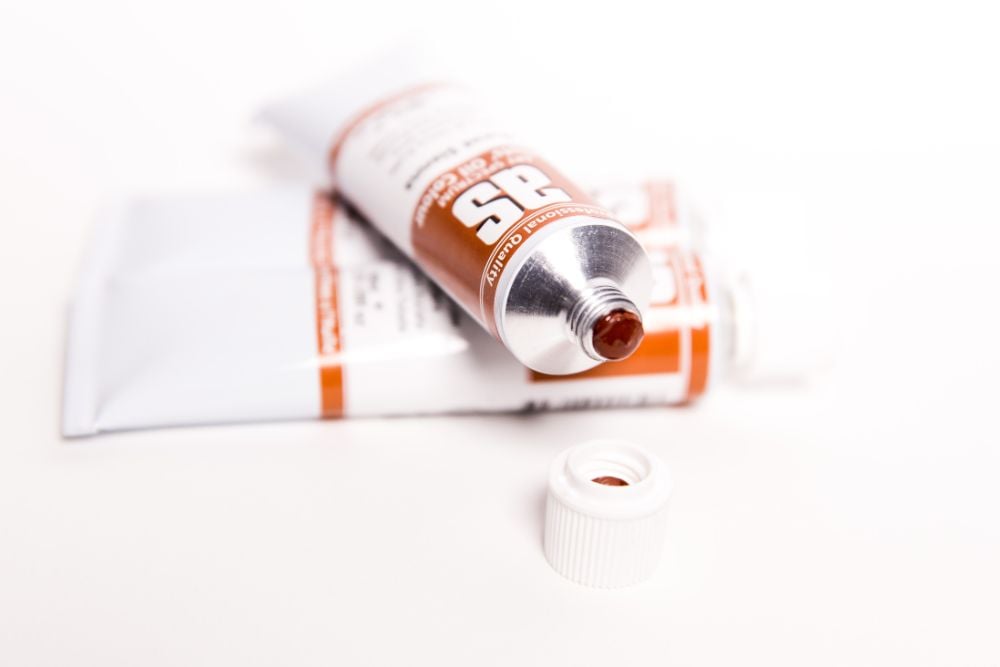
Invest in quality art supplies to further your art career. Click here to shop Bluethumb Art Supplies.
To produce art, an investment of money is needed to purchase essential equipment and materials. It can be tempting to try to save money by using cheap materials, but this is false economy as substandard materials are harder to work with and produce inferior results. If you are selling your artwork, it is important to invest in artist quality materials that are archival and enhance your professional reputation with buyers and collectors. You don’t want to risk paint cracking or fading or a canvas warping over time.
The need for investing in good quality materials and equipment can uncover the self-limiting belief, “I can’t afford it”. It is easy for someone to tell you to change this mindset, but you may be faced with a financial reality that makes it hard for you to see anything different. So, if this is your point of resistance, start by acknowledging that you do have some cash flowing in and cash flowing out and that you do make daily choices about how much you spend, what you spend it on, what’s important to save for and how much you can save.
If your art is important to you, you must give yourself permission to spend money on it in a guilt-free way. If you have surplus funds, it may be easier to allow yourself to invest in your art career. If you have a shortage of funds, then your investment will not be as great, but it is still possible. Many people are scared by the term “financial investment”, equating it with thousands of dollars’ worth of debt. But when we are talking about a financial investment in art materials, it may be as little as $5 more for an artist quality tube of paint rather than the cheap student version. If you are on a tight budget, try to shop for art materials when they are on sale and let friends and family know that for birthday and Christmas, a gift voucher for your favourite art store would be perfect.
Relaxing into the idea of making an investment that you can afford, starts to shift your mindset from a reluctance to spend money to the realisation that allowing yourself to invest in your art career can actually lead to more funds. When you are ready to transition from hobbyist status to making art your business, then as well as paying tax on income from art sales, you can claim the cost of art materials as a business expense. Knowing that you can claim your investment back on your income tax return can help shift your hesitation into permission for legitimate spending. Government grants can also assist with larger investments for big projects.
Art Career Tip 2: Education and Training

Bluethumb Curator Sarah with VP Sales Sheeraz run webinars every other week to help you with your art career. Click here to watch them.
Producing exceptional work usually requires some form of preliminary as well as ongoing education and training where skills are learned, practiced, developed, and updated over time. However, this does not necessarily involve the conventional approach of financially investing in art school training. Self-taught artists are by definition immersed in self-directed learning. Their investment in education and training may be more in the form of time and commitment rather than actual dollars. Information about technique can be learned from books (bought or borrowed), online demonstrations, the promotion of product manufacturers, and viewing the work of other artists. Then it is a process of trial and error where experience and practice become the educators. Don’t underestimate the value of personal experimentation as this is when artistic innovation is likely to occur.
Art Career Tip 3: Dedicated Work Space
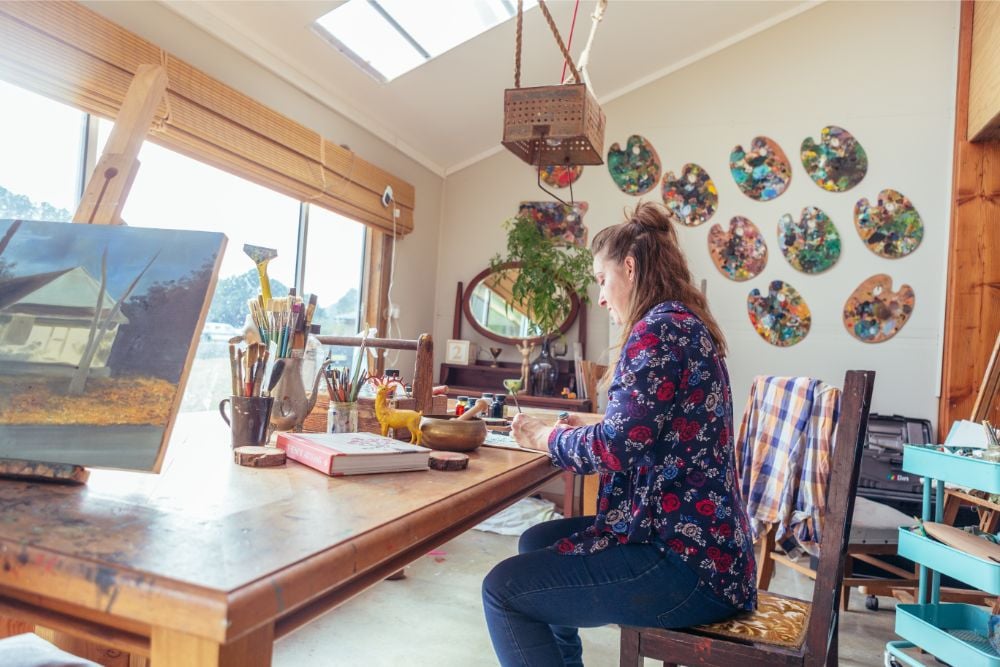
Llael McDonald knows the value of investing a little in her work space.
The space required to produce your artwork will depend on your art form. Some artists need a large workshop for lots of specialist equipment, whereas plein air painters only need to step outdoors. It also depends on personal preference with some artists needing to lock themselves away from distraction in their own studio whereas others don’t mind creating art on the kitchen bench with their family around. Whatever your circumstances, ensure your work space is conducive to producing the best art possible, you feel comfortable in that setting and your artistic vision and creativity is not being compromised. This is the ultimate criteria to use when deciding if you need to invest in this aspect of your business. Your financial investment in work space may be as simple as purchasing a freestanding easel rather than actually building a studio.
This brings us to the second self-limiting belief, “I should not spend money on myself”. Many artists undervalue themselves and feel guilty about spending money on their business, feeling they should be directing those funds towards the needs of other members of their family. If you can acknowledge that your needs are as important as those of others and that you are worthy of happiness, then this shift in perception can have beneficial ramifications for you, your art career and others in your life. By taking yourself seriously as an artist and investing in an effective work space, you also send a powerful message about how you wish to be viewed by others.
Art Career Tip 4: Professional Image and Brand
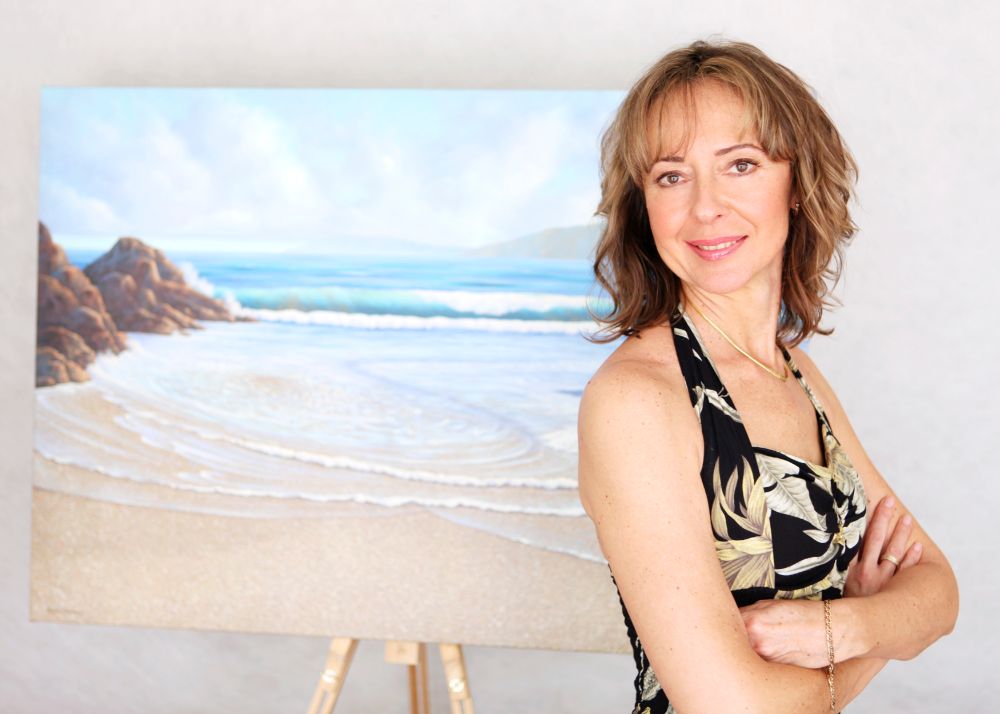
My professional headshot. The power of these new headshots to enhance my professional image was immediate. See it in action on my Bluethumb profile.
Your professional image and branding of your business comes across in every interaction with your audience, whether that is face to face, via printed material, or your online presence. After deciding what that branding will be, it is important to ensure a consistent projection of that image. This may involve an investment of resources in obvious as well as sometimes overlooked areas of your business. Consider the following: the choice of clothes you wear to opening night, the clarity of photographs of your artwork, the quality of paper that your flyers and business cards are printed on, the voicemail message on your phone, and the accuracy of spelling and grammar on your website. Many of these things are not contingent upon money, but rather a professional attitude.
Like many artists, I was more concerned with the presentation of my artwork than of me as an artist. As a result, when a headshot was required for a publication or gallery promotion, I made do with a quick photo that my husband took of me in the studio. However, when my photograph was required for the back cover of the book I was publishing, I felt it was time to finally invest in a professional photographer. I knew that just spending money was no guarantee of a return on my investment, so I researched the quality of work of several photographers and chose one that I could afford, knowing that I would be able to claim the business expense as a tax deduction.
As I am an artist, writer and international art tutor, I had an idea about the professional image I wanted to project in each area of my business. The photographer was able to capture the looks that support my branding in all these areas of my business, not just my book cover. I updated the headshots on my website, in my newsletter, on the websites of galleries that represent my work, on flyers for my painting retreats, in magazines I write for, and in media releases. The power of these new headshots to enhance my professional image was immediate. When I pondered why I hadn’t done it sooner, I realised that I had assumed it would be far more expensive than it actually was, and I had not given myself permission to spend that money on myself. If you are not yet registered as a business and cannot afford a professional headshot, then recruit a friend who is good with a camera to take the photographs for you. Think carefully about how you want to present yourself and your artwork to the world as this is your branding. What impression does your headshot create in the minds of prospective buyers?
Art Career Tip 5: Retail Outlet

Bluethumb dream team Sarah and Freddy were just at the Revealed Aboriginal Art Market in Fremantle last weekend getting artists’ work out there and into collectors’ homes.
After creating a body of work, it is necessary to establish some kind of retail outlet where your work can be seen and purchased. You can choose whether to invest mostly time or money into the promoting and selling of your work. The common options for artists include: designing your own website or employing an expert to do it for you, finding gallery representation or hiring an exhibition space, developing free social media pages or taking out paid advertising in magazines, setting up a profile on an online gallery or renting a space in art festivals. Bluethumb is a great free option and covers lots of these bases.
This brings us to the third self-limiting belief that stops artists from investing in their art career – “I don’t know what to charge for this artwork”. When artists undervalue their work, time and talent, they tend to undercharge and even regularly give work away. They may claim that they are not in it for the money and so consistently make a loss. The bottom line of being a professional artist is that you are running a business. That means maximising income and minimising costs through wise spending choices. There are creative ways to invest in your art career on a budget that will lead to financial growth and career development. When you value yourself, your artwork and your business, it is worth the investment of resources.
Biography
Elena Parashko is an award-winning artist, writer and teacher. Her artwork is held in private and corporate collections and galleries throughout Australia and overseas. As a trained teacher with a Bachelor of Education and Masters in Adult Education, Elena is a regular international tutor of art in Fiji, Tahiti, Bora Bora, Hamilton Island, Norfolk Island and the Maldives.
Elena is a writer for Leisure Painter magazine in the UK and Professional Artist magazine in the USA. She is the author of the empowering book, Survival Guide for Artists: How to Thrive in the Creative Arts for all creative people wanting to live the life of their dreams. For your nearest stockist contact National Art Materials P/L in Australia on 0397203322 or email: sales@nationalart.com.au

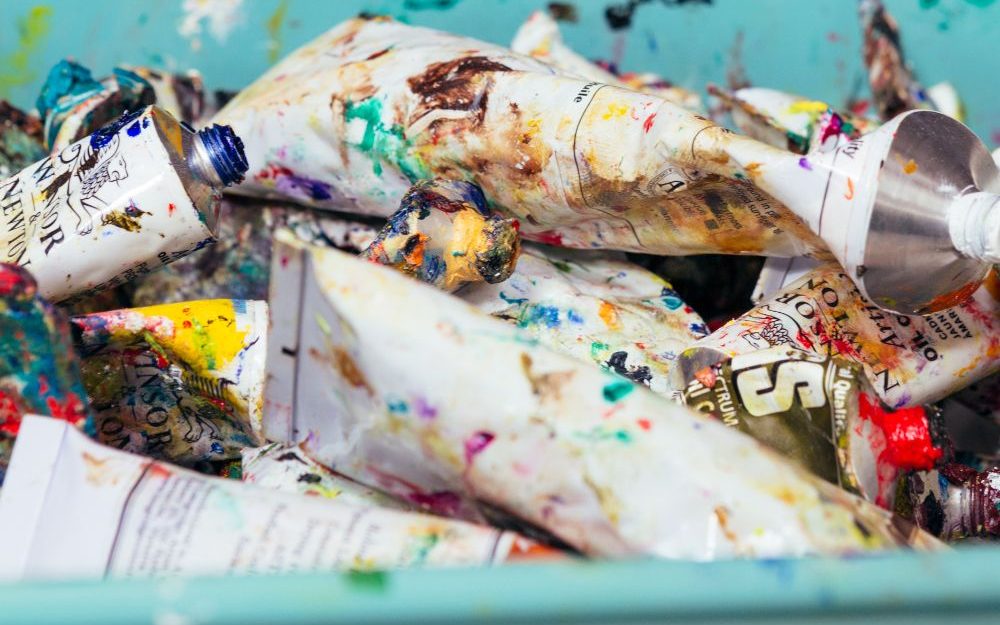
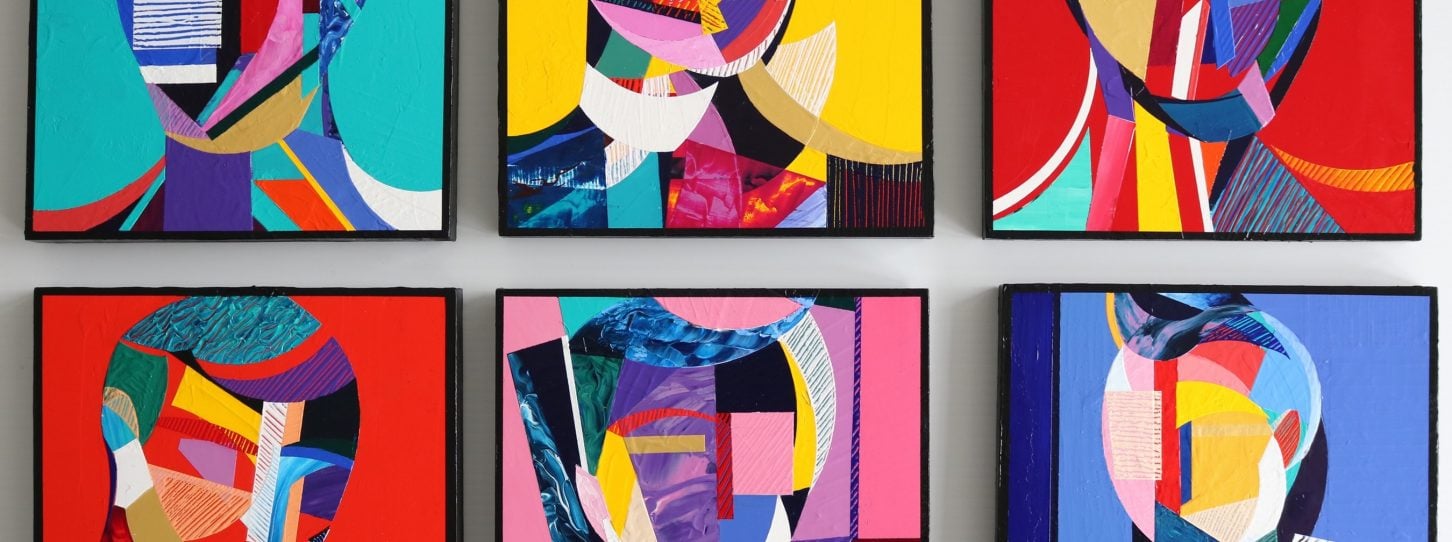
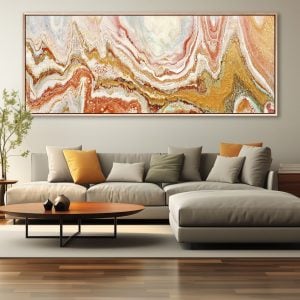










cannot put my email address into the subscription of your newsletter dont know why as i have had it for years and is accepted everywhere else
Hey Bev, by the looks of it you’re already subscribed. So happy you love our content! 🙂
Loved reading this, so TRUE.
This artist has NO studio, not much space but her tiny unit where I do most of my work.
That is why I can`t produce anything bigger that A1 art..
But I have NO major complaints really, I am happy doing what I like.
I share my life and art with my Samantha, (my siamese princess), xxxxx
Thanks Lilly! 🙂
Fantastic article and so informative, not to mention great timing! I’m in process of transitioning out of my current business (not related to the art industry) and will be a full time artist from around August 2019, so articles like this reinforce my recent business decisions… so exciting! Best, Eve x
Thanks Eve. I’m pleased you found my article so helpful. I cover this topic in more detail as well as other common issues artists faced in my book, “Survival Guide for Artists: How to Thrive in the Creative Arts”. It’s available at: http://www.elenaparashko.com/Book.htm
Loved the read and great advice. Thank you for a well thought out, well written article. I love to buy new art supplies and you’ve just given me a good reason .
Now, about that bucket list trip to France…?
Thank you for this great article. Very interesting reading and helpful tips.
Regards Maria
Thanks for a great read, and a perhaps the kick up the backside I needed! I am guilty of undervaluing my work (knocking back offers from family members to pay for my work – yes I know, I’m an idiot!). But I’m turning my mindset around. I have invested much time and money getting to where I am already, with a Cert IV, Dip Visual Art and a degree in visual communication in the last 12 years. Not to mention countless hours painting, drawing, printmaking. Having just been approved for a two week residency later in the year, it’s time to step things up a notch!
Such a great article and a good guideline for self reflection and making changes in my art business! Thank you for sharing.